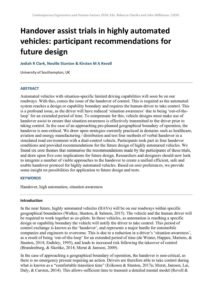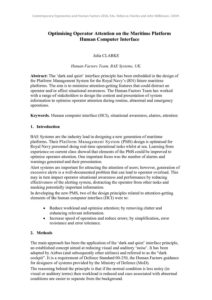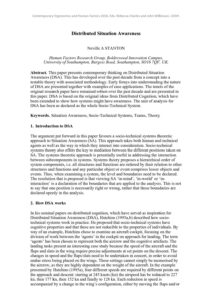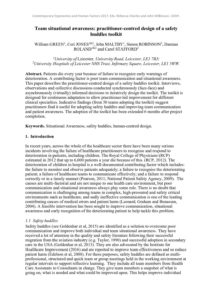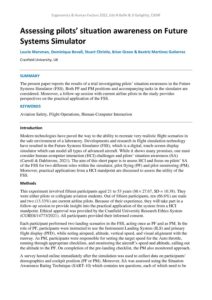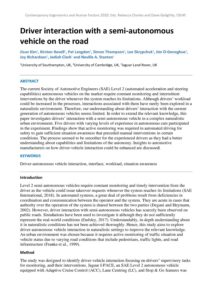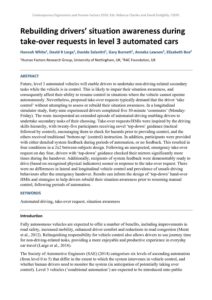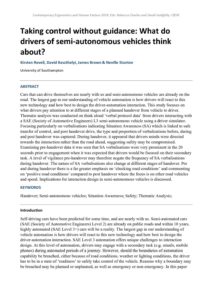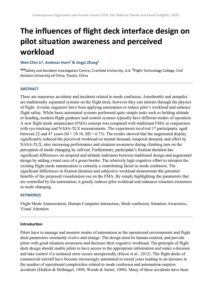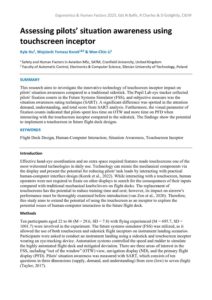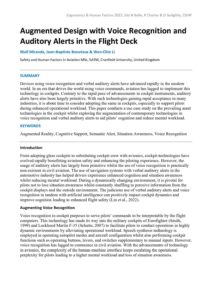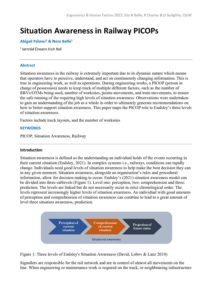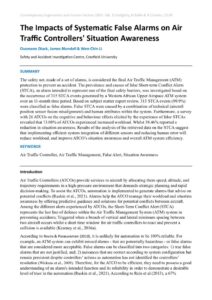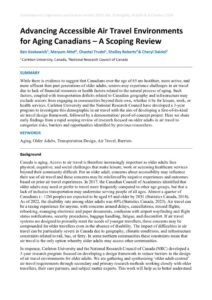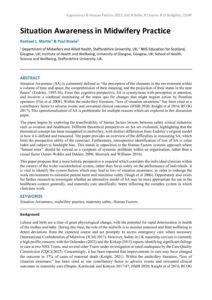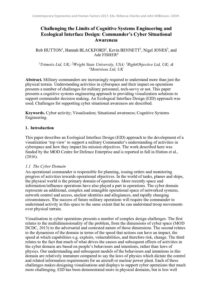Situation awareness
Handover assist trials in highly automated vehicles: participant recommendations for future design
| Document | Author Jediah R Clark, Neville Stanton & Kirsten M A Revell |
| Abstract Automated vehicles with situation-specific limited driving capabilities will soon be on our roadways. With this, comes the issue of the handover of control. This is required as the automated system reaches a design or capability boundary and requires the human-driver to take control. This is a profound issue, as the driver will have reduced ‘situation awareness’ due to being ‘out-of-the-loop’ for an extended period of time. To compensate for this, vehicle designs must make use of handover assist to ensure that situation awareness is effectively transmitted to the driver prior to taking control. In the case of an approaching pre-planned geographical boundary of operation, the handover is non-critical. We draw upon strategies currently practiced in domains such as healthcare, aviation and energy manufacturing / distribution and test four methods of verbal handover in a simulated road environment with a dual-control vehicle. Participants took part in four handover conditions and provided recommendations for the future design of highly automated vehicles. We found six core themes that summarise the recommendations made by the participants of these trials, and draw upon five core implications for future design. Researchers and designers should now look to integrate a number of viable approaches to the handover to create a unified efficient, safe and usable handover protocol for highly automated vehicles. Based on user preferences, we provide some insight on possibilities for application to future design and tests. |
Optimising Operator Attention on the Maritime Platform Human Computer Interface
| Document | Author Julia CLARKE |
| Abstract The ‘dark and quiet’ interface principle has been embedded in the design of the Platform Management System for the Royal Navy’s (RN) future maritime platforms. The aim is to minimise attention-getting features that could distract an operator and/or affect situational awareness. The Human Factors Team has worked with a range of stakeholders to design the content and presentation of system information to optimise operator attention during routine, abnormal and emergency operations. |
Distributed Situation Awareness
| Document | Author Neville A STANTON |
| Abstract This paper presents contemporary thinking on Distributed Situation Awareness (DSA). This has developed over the past decade from a concept into a testable theory with associated methodology. Early forays into understanding the nature of DSA are presented together with examples of case applications. The tenets of the original research paper have remained robust over the past decade and are presented in this paper. DSA is based on the original ideas from Distributed Cognition, which have been extended to show how systems might have awareness. The unit of analysis for DSA has been as declared as the whole Socio-Technical System. |
Team situational awareness: practitioner-centred design of a safety huddles toolkit
| Document | Author William GREEN, Ceri JONES, John MALTBY, Simon ROBINSON, Damian ROLAND and Carol STAFFORD |
| Abstract Patients die every year because of failure to recognize early warnings of deterioration. A contributing factor is poor team communication and situational awareness. This paper describes the practitioner-centred design of a safety huddles toolkit. Interviews, observations and collective discussions conducted synchronously (face-face) and asynchronously (virtually) informed decisions to iteratively design the toolkit. The toolkit is designed for continuous adaptation to allow practitioner-led improvement for different clinical specialties. Indicative findings (from 50 teams adopting the toolkit) suggest practitioners find it useful for adopting safety huddles and improving team communication and patient awareness. The adoption of the toolkit has been extended 6 months after project completion. |
Assessing pilots’ situation awareness on Future Systems Simulator
| Document | Author Laurie Marsman, Dominique Bovell, Stuart Christie, Brian Green & Beatriz Martinez Gutierrez |
| Abstract The present paper reports the results of a trial investigating pilots’ situation awareness in the Future Systems Simulator (FSS). Both PF and PM positions and accompanying tasks in the simulator are considered. Moreover, a follow-up session with current airline pilots in the study provides perspectives on the practical application of the FSS. |
Towards Agent-Based Modelling for Situation Awareness: modeling a ships Operations Room
| Document | Author Joanne KITCHIN and Chris BABER |
| Abstract An Agent-Based Model of a Maritime Operations Room is developed. Different versions of the model are run to compare the impact of team structure and information management on performance. The aim of the work is to model Situation Awareness in terms of information flow and team structure. From a description of information flow and operator activity in an Ops Room, we defined key roles, information use and communication for Agents in a model. The model allows us to define rules that reflect different modes of activity. Clear performances are found between structures and this is interpreted in terms of Situation Awareness. |
Driver interaction with a semi-autonomous vehicle on the road
| Document | Author Jisun Kim, Kirsten Revell, Pat Langdon, Simon Thompson, Lee Skrypchuk, Jim O-Donoghue, Joy Richardson, Jediah Clark and Neville A. Stanton |
| Abstract The current Society of Automotive Engineers (SAE) Level 2 (automated acceleration and steering capabilities) autonomous vehicles on the market require constant monitoring and intermittent interventions by the driver whenever the system reaches its limitations. Although drivers’ workload could be increased in the processes, interactions associated with them have rarely been explored in a naturalistic environment. Therefore, our understanding about drivers’ interaction with the current generation of autonomous vehicles seems limited. In order to extend the relevant knowledge, this paper investigates drivers’ interaction with a semi-autonomous vehicle in a complex naturalistic urban environment. Five drivers with varying levels of experience in autonomous cars participated in the experiment. Findings show that active monitoring was required in automated driving for safety to gain sufficient situation awareness that preceded manual interventions in certain conditions. The process seemed to be smoother for the experienced drivers as they had a better understanding about capabilities and limitations of the autonomy. Insights to automotive manufacturers on how driver-vehicle interaction could be enhanced are discussed. |
Rebuilding drivers’ situation awareness during take-over requests in level 3 automated cars
| Document | Author Hannah White, David R Large, Davide Salanitri, Gary Burnett, Anneka Lawson, Elizabeth Box |
| Abstract Future, level 3 automated vehicles will enable drivers to undertake non-driving-related secondary tasks while the vehicle is in control. This is likely to impair their situation awareness, and consequently affect their ability to resume control in situations where the vehicle cannot operate autonomously. Nevertheless, proposed take-over requests typically demand that the driver ‘take control’ without attempting to assess or rebuild their situation awareness. In a longitudinal simulator study, forty-nine experienced drivers completed five 30-minute ‘commutes’ (Monday-Friday). The route incorporated an extended episode of automated driving enabling drivers to undertake secondary tasks of their choosing. Take-over requests/HMIs were inspired by the driving skills hierarchy, with twenty-five participants receiving novel ‘top-down’ guidance (tactical followed by control), encouraging them to check for hazards prior to providing control, and the others received traditional ‘bottom-up’ (control) instruction. In addition, participants were provided with either detailed system feedback during periods of automation, or no feedback. This resulted in four conditions in a 2x2 between-subjects design. Following an unexpected, emergency take-over request on day four, drivers with ‘top-down’ guidance checked their mirrors significantly more times during the handover. Additionally, recipients of system feedback were demonstrably ready to drive (based on recognised physical indicators) sooner in response to the take-over request. There were no differences in lateral and longitudinal vehicle control and prevalence of unsafe driving behaviours after the emergency handover. Results can inform the design of ‘top-down’ hand-over HMIs and strategies to help drivers rebuild their situation awareness prior to resuming manual control, following periods of automation. |
Taking control without guidance: What do drivers of semi-autonomous vehicles think about?
| Document | Author Kirsten Revell, David Keszthelyi, James Brown & Neville Stanton |
| Abstract Cars that can drive themselves are nearly with us and semi-autonomous vehicles are already on the road. The largest gap in our understanding of vehicle automation is how drivers will react to this new technology and how best to design the driver-automation interaction. This study focuses on what drivers pay attention to at different stages of a planned handover from vehicle to driver. Thematic analysis was conducted on think aloud ‘verbal protocol data’ from drivers interacting with a SAE (Society of Automotive Engineers) L3 semi-autonomous vehicle using a driver simulator. Focusing particularly on verbalisations indicating Situation Awareness (SA) which is linked to safe transfer of control, and post handover drive, the type and proportion of verbalisations before, during and post handover was captured. During handover, it appeared that drivers minds were directed towards the interaction rather than the road ahead, suggesting safety may be compromised. Examining pre-handover data it was seen that SA verbalisations were very prominent in the 20 seconds prior to engagement when it was expected that drivers would be focused on their secondary task. A level of vigilance pre-handover may therefore negate the frequency of SA verbalisations during handover. The nature of SA verbalisations also change at different stages of handover. Pre and during handover there is a far greater emphasis on ‘checking road conditions’ and commenting on ‘positive road conditions’ compared to post handover where the focus is on other road vehicles and speed. Implications for interaction design in semi-autonomous vehicles is discussed. |
The influences of flight deck interface design on pilot situation awareness and perceived workload
| Document | Author Wen-Chin Li, Andreas Horn & Jingyi Zhang |
| Abstract There are numerous accidents and incidents related to mode confusion. Autothrottle and autopilot are traditionally separated systems on the flight deck, however they can interact through the physics of flight. Avionic engineers have been applying automation to reduce pilot’s workload and enhance flight safety. While basic automated systems performed quite simple tasks such as holding altitude or heading, modern flight guidance and control systems typically have different modes of operation. A new flight mode annunciator (FMA) concept was compared with traditional FMA in conjunction with eye-tracking and NASA-TLX measurements. The experiment involved 17 participants, aged between 22 and 47 years (M = 29.18, SD = 6.73). The results showed that the augmented display significantly reduced the perceived workload on mental demand, temporal demand, and effort by NASA-TLX; also increasing performance and situation awareness during climbing turn on the perception of mode changing by call-out. Furthermore, participant’s fixation duration has significant differences on airspeed and altitude indicators between traditional design and augmented design by adding visual cues of a green border. The relatively high cognitive effort to interpret the existing flight mode annunciation is certainly a contributing factor in mode confusion. The significant differences in fixation duration and subjective workload demonstrate the potential benefits of the proposed visualization cue on the FMA. By simply highlighting the parameters that are controlled by the automation, it greatly reduces pilot workload and enhances situation awareness in mode changing. |
Assessing pilots’ situation awareness using touchscreen inceptor
| Document | Author Kyle Hu, Wojciech Tomasz Korek & Wen-Chin Li |
| Abstract This research aims to investigate the innovative technology of touchscreen inceptor impact on pilots' situation awareness compared to a traditional sidestick. The Pupil Lab eye tracker collected pilots' fixation counts in the Future Systems Simulator (FSS), and subjective measure was the situation awareness rating technique (SART). A significant difference was spotted in the attention demand, understanding, and total score from SART analysis. Furthermore, the visual parameter of fixation counts indicated that pilots spent less time on OTW and more time on PFD when interacting with the touchscreen inceptor compared to the sidestick. The findings show the potential to implement a touchscreen in future flight deck designs. |
Augmented Design with Voice Recognition and Auditory Alerts in the Flight Deck
| Document | Author Niall Miranda, Jean-Baptiste Bonotaux & Wen-Chin Li |
| Abstract Devices using voice recognition and verbal auditory alerts have advanced rapidly in the modern world. In an era that drives the world using voice commands, aviation has lagged to implement this technology in cockpits. Contrary to the rapid pace of advancements in cockpit instruments, auditory alerts have also been largely primitive. With such technologies gaining rapid acceptance in many industries, it is about time to consider adopting the same in cockpits, especially to support pilots during enhanced operational workload. This paper conducts a use case study on the prevailing aural technologies in the cockpit whilst exploring the augmentation of contemporary technologies in voice recognition and verbal auditory alerts to aid pilots’ cognition and reduce mental workload. |
Situation Awareness in Railway PICOPs
| Document | Author Abigail Palmer & Nora Balfe |
| Abstract Situation awareness in the railway is extremely important due to its dynamic nature which means that operators have to perceive, understand, and act on continuously changing information. This is true in engineering work, as well as operations. During engineering works, a PICOP (person in charge of possession) needs to keep track of multiple different factors, such as the number of RRVs/OTMs being used, number of worksites, points movements, and train movements, to ensure the safe running of the requiring high levels of situation awareness. Observations were undertaken to gain an understanding of the job as a whole in order to ultimately generate recommendations on how to better support situation awareness. This paper maps the PICOP role to Endsley’s three levels of situation awareness. Factors include track layouts, and the number of worksites |
The Impacts of Systematic False Alarms on Air Traffic Controllers’ Situation Awareness
| Document | Author Ousmane Diack, James Blundell & Wen-Chin Li |
| Abstract The safety net, made of a set of alarms, is considered the final Air Traffic Management (ATM) protection to prevent an accident. The prevalence and causes of false Short-term Conflict Alerts (STCA), an alarm intended to represent one of the final safety barriers, was investigated based on the occurrence of 315 STCA events generated by a Western African Upper Airspace ATM system over an 11-month time period. Based on subject matter expert review, 313 STCA events (99.9%) were classified as false alarms. False STCA were caused by a combination of technical (aircraft position sensor fusion misalignment) and human attributes within the system. Furthermore, a survey with 26 ATCOs on the cognitive and behaviour effects elicited by the experience of false STCAs revealed that 73.08% of ATCOs experienced increased workload. Whilst 38.46% reported a reduction in situation awareness. Results of the analysis of the retrieved data on the STCA suggest that implementing efficient system integration of different sensors and reducing human error will reduce workload, and improve ATCO’s situation awareness and overall ATM system efficiency. |
Advancing Accessible Air Travel Environments for Aging Canadians – A Scoping Review
| Document | Author Ben Koskowich , Maryam Attef, Chantal Trudel, Shelley Roberts& Cheryl Dalziel |
| Abstract While there is evidence to suggest that Canadians over the age of 65 are healthier, more active, and more affluent than past generations of older adults, seniors may experience challenges in air travel due to lack of financial resources or health factors related to the natural process of aging. Such factors, coupled with transportation deficits related to Canadian geography and infrastructure may exclude seniors from engaging in communities beyond their own, whether it be for leisure, work, or health services. Carleton University and the National Research Council have developed a 3-year program to investigate this demographic in air travel with the aim of developing a first-of-its-kind air travel design framework, followed by a demonstration/ proof-of-concept project. Here we share early findings from a rapid scoping review of research focused on older adults in air travel to categorize risks, barriers and opportunities identified by previous researchers. |
Situation Awareness in Midwifery Practice
| Document | Author Rachael L. Martin & Paul Bowie |
| Abstract Situation Awareness (SA) is commonly defined as “the perception of the elements in the environment within a volume of time and space, the comprehension of their meaning, and the projection of their status in the near future” (Endsley, 1995:36). From this cognitive perspective, SA is synonymous with perception or attention, and involves a continual monitoring of the status quo for changes that might require action by frontline operators (Flin et al 2008). Within the midwifery literature, “loss of situation awareness” has been cited as a contributory factor to adverse events and unwanted clinical outcomes (HSIB 2020; Knight et al 2014; RCOG 2017). This operationalisation of SA is problematic for multiple reasons which are explored in this discussion paper. The paper begins by exploring the transferability of human factors lessons between safety critical industries such as aviation and healthcare. Different theoretical perspectives on SA are evaluated, highlighting that the theoretical concept has been misapplied in midwifery, with distinct differences from Endsley’s original model in how it is defined and measured. The paper provides an overview of the difficulties in measuring SA, which limit the prospective utility of the construct. Furthermore, retrospective identification of loss of SA is value laden and subject to hindsight bias. This stands in opposition to the Human Factors systems approach where “human error” should be viewed as a symptom of systemic problems within an organisation, rather than a causal factor (Amer-Wahlin and Dekker, 2008; Shorrock and Williams 2016). This paper proposes that a more holistic perspective is required which considers the individual clinician within the context of the wider sociotechnical system, rather than focus solely on the performance of individuals. It is vital to identify the system factors which may lead to loss of situation awareness, in order to redesign the work environment to minimise patient harm and maximise safety (Singh et al 2006). Opportunity also exists for further research to investigate whether an alternative model of SA may be more appropriate for use in the healthcare context generally, and maternity care specifically, better reflecting the complex system in which clinicians work. |
Challenging the Limits of Cognitive Systems Engineering and Ecological Interface Design: Commander’s Cyber Situational Awareness
| Document | Author Rob HUTTON, Hannah BLACKFORD, Kevin BENNETT, Nigel JONES, and Ade FISHER |
| Abstract Military commanders are increasingly required to understand more than just the physical terrain. Understanding activities in cyberspace and their impact on operations presents a number of challenges for military personnel, tech-savvy or not. This paper presents a cognitive systems engineering approach to providing visualization solutions to support commander decision making. An Ecological Interface Design (EID) approach was used. Challenges for supporting cyber situational awareness are described. |
Exploratory study of virtual reality flight training device for upset prevention and recovery training
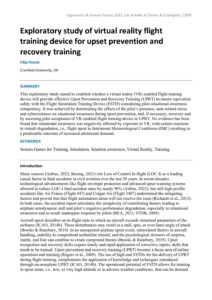
| Document
Insert here |
Author Filip Florek |
| Abstract This exploratory study aimed to establish whether a virtual reality (VR) enabled flight training device will provide effective Upset Prevention and Recovery Training (UPRT) to ensure equivalent safety with the Flight Simulation Training Device (FSTD) considering pilot situational awareness competency. It was achieved by determining the effects of the pilot’s presence, task-related stress and cybersickness on situational awareness during upset prevention, and, if necessary, recovery and by assessing pilot acceptance of VR-enabled flight training device in UPRT. No evidence has been found that situational awareness was negatively affected by exposure to VR, with certain reactions to stimuli degradation, i.e., flight upset in Instrument Meteorological Conditions (IMC) resulting in a predictable outcome of increased attentional demand. |

